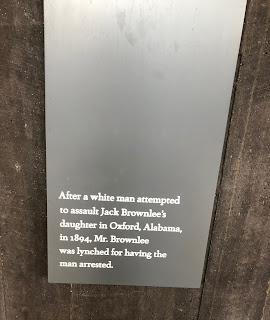Jenny and I took a
trip to Montgomery on Saturday. While we were there we visited the Legacy Museum and the National
Memorial for Peace and Justice. The museum covers the history of the
African slave trade in America and the memorial is honor and memory of the over
4,400 African Americans lynched by white mobs from 1877 to 1950. The museum and
memorial were both powerful reminders of our history and the work yet to be
done.
Here are a few
impressions that stayed in my mind.
·
The power of art to
convey information and feeling.
o
There was a powerful
data visualization showing the movement of the slave population in the United
States from the early 1800s when there were approximately 650,000 African
slaves to immediately prior to the Civil War when there were nearly 4 million.
o
An animated watercolor
showing what life was like for African slaves and the pain of family separation.
o
Jars of dirt from the
ground where lynchings occurred memorializing the individual victims by name.
o
A wall showed all the
signs that were used during the Jim Crow era to segregate and marginalize African-Americans.
o
Interactive maps
showed the numbers and names of lynchings from individual counties.
Lest anyone think this
is ancient history, a sign at the museum reminds us that school segregation is
still written into the Alabama state constitution and ballot initiatives to
remove the language failed in 2004 and 2012. While it’s clearly unconstitutional
and unenforceable, the symbolism is undeniable.
By far The National
Memorial for Peace and Justice presented the most memorable images.
·
Small plaques, about 100
of them, told brief tweet-length stories of the lynchings. People murdered for “hanging
around in a white neighborhood”, protesting low wages, having a white man
arrested for assaulting his wife and drinking from a white man’s well.
And finally, most
powerfully, hanging coffin-shaped boxes of rusting steel, first at eye level,
then hanging above you as you descend into the memorial. There are 800 boxes,
one for each county with a recorded lynching. The names of the victims are
etched in the boxes, often simply stating “unknown”. Some boxes have one name,
some dozens. In one county 23 people were lynched in a single day.
I learned about the museum
and memorial after reading Just Mercy by Bryan Stevenson earlier this
year. Stevenson is an attorney who founded the Equal Justice Initiative and who
represents death row inmates and works to abolish the death penalty. Excellent,
compelling book and well worth the read.
I should also note this is not a "black museum". The crowd was 90-95% African American. Everyone should visit and all schools within 250 miles should make it a required field trip (that makes sure Forsyth county is there).
I should also note this is not a "black museum". The crowd was 90-95% African American. Everyone should visit and all schools within 250 miles should make it a required field trip (that makes sure Forsyth county is there).
I’ll leave you with
pictures from the visit that say more than I ever could.










